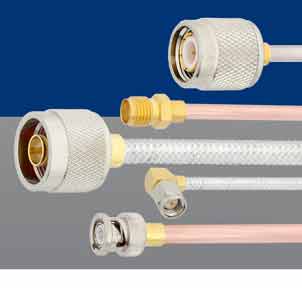In its most basic form, a semi-rigid cable assembly is a coaxial transmission line consisting of a metal tube, typically made from copper which forms the outer conductor with a metal wire conductor running down the center of the tube. The center conductor is supported by a dielectric material that keeps the wire centered in the tube along the same axis of the outer conductor.
Here are the five most important things to know about semi-rigid cables:
semi-rigid cable assemblies from Pasternack
1) They are stand-alone microwave components. It is good to remember that a semi-rigid cable assembly is in itself a key microwave component, meaning that the specifications of a semi-rigid cable are just as important as any coupler, hybrid, or even amplifier. A properly made cable successfully connects other components in the system with a known and stable effect. If you take a look at any good link budget analysis, you will see how the electrical parameters, including attenuation and VSWR at a given frequency play a vital role in the transmission and reception of RF signals. To compare semi-rigid cables to standard RG-type cables, consider this; a space qualified semi-rigid cable assembly using soldered connectors can take an hour or more per attachment if carefully inspected, thermal cycled, and properly tested. In contrast, RF connectors using a crimp attachment designed for a flexible (non semi-rigid) coax can be attached and completed in a minute or less.
2) They have a wide frequency range. Semi-rigid cable assemblies commonly support RF signal transmissions up to 65 GHz. Although not as common, higher frequency applications up to 110 GHz are possible using a cable terminated with 1.0mm connectors. Semi-rigid coax comes in a variety of sizes ranging from 0.020 inches in diameter up to 0.250 inches in diameter. Some of the more popular sizes at Pasternack include 0.141†and 0.086â€, with 0.047†diameter gaining in popularity to support higher frequencies utilizing smaller form factor connectors. 0.141 inch diameter semi-rigid coax terminated with high frequency SMA’s or 2.92mm connectors is commonly used in applications up to 27 GHz. 0.086 inch diameter semi-rigid coax is also popular with SMA connectors, but will work up to 65 GHz when terminated with 1.85mm connectors.
3) They can be formed into shape and they will keep their shape. It is often necessary for these cable assemblies to be formed into precise shapes to allow proper fit into the system for which it is designed. As the name implies, semi-rigid coax is rigid enough to hold its shape when formed yet pliable enough to be bent by hand. Forming a semi-rigid cable is risky business and should be done using specialized tools that allow the cable to be bent or formed into shape without damaging the wall of the outer tubing. Reforming a cable is difficult and often results in damage to the outer conductor, causing ripples in the outer wall that will affect the electrical performance of the cable assembly. Aluminum and soft copper is easier to form and simple bends can be done by hand, but specialized hand tools are still recommended to minimize the risk of damage to the coax.
Formable or semi-flexible coax is another popular type of coax often grouped with semi-rigid coax. Formable semi-rigid coax employs a tin-filled outer braid over a conductive spiral wrapped foil, forming a somewhat flexible outer conductor when compared to a solid metal outer conductor. These semi-rigid substitutes are typically formed by hand and will keep their general shape, but not as well as standard semi-rigid coax. These flexible cable alternatives have become very popular since complex routing and assembly drawings are usually not required. The hand formable cables can be purchased in small length increments and formed into the desired shape as the products are assembled. The electrical performance is close to that of a solid wall semi-rigid coax and is less expensive to produce. These cables are also available with or without a protective jacket material.
4) They are phase-stable. Because of the high quality materials used to make semi-rigid cables, they are very electrically stable when compared to flexible coax using a braided wire outer conductor. The properties of the metals and dielectric materials will change with temperature fluctuation, which is why it is important to use phase stable cables in many critical systems. It is common to use phase matched semi-rigid cables in systems requiring controlled phase lengths. This is very true in antenna systems including phased array antennas where the phase of the input signal is used to electrically steer the main beam of an antenna array. Modern mobile communications systems employ this technique to optimize coverage under changing conditions, reducing the number of antennas required to optimize system performance.
5) Low PIM (low passive intermodulation) – Semi-rigid cable assemblies are generally constructed of non-ferrous materials, mainly copper. When combined with the proper connectors, the copper tube semi-rigid coax has very good PIM performance, making them ideal for use in modern multi-frequency wireless communications systems including DAS (Distributed Antenna Systems)-related equipment. As the need for ubiquitous coverage grows, the requirements of the DAS market has created a demand for more low PIM products, ranging from power dividers, combiners, and amplifiers to high end test equipment. Semi-rigid cable assemblies are a natural fit for these applications, capable of meeting the demanding RF power and PIM requirements of modern wireless communication systems.
In summary, semi-rigid cable assemblies are critically important microwave components used in many RF applications active around the globe. Although semi-rigid technology is not new, these assemblies are still a very popular choice among engineers due to their broad frequency capabilities, reliable electrical performance and phase stability.

